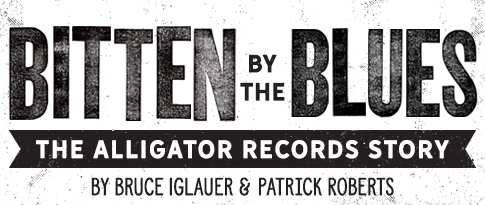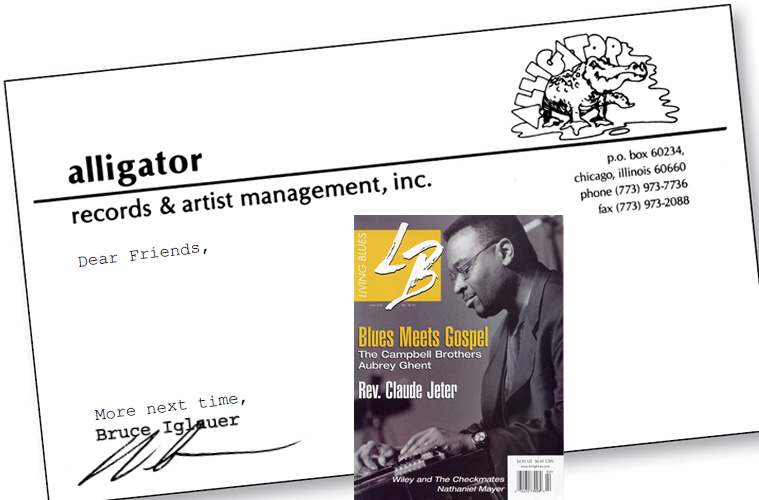Dear Friends,
By the time you read this, Alligator will have three new releases ready for you to enjoy. On January 11, we’re releasing our second Roomful of Blues album, Standing Room Only. Since Mark DuFresne joined the band as lead vocalist, Roomful has totally returned to its swing/jump/big band roots. The horns have never sounded better, and Chris Vachon’s economical, stinging guitar ignites the band. For Standing Room Only, the band contributes eight brand new songs as well as bringing some obscure blues oldies to light. If you tuned out Roomful in the ’90s when they were melding more contemporary rock and R&B with their blues, it’s time to come back (like they did) to the real Roomful of Blues, the band that first brought the horn-driven R&B of the ’40s and ’50s to today’s audience. You won’t be sorry.
If you like to listen to something less traditional, check out Corky Siegel’s Traveling Chamber Blues Show, which will also be released on January 11. Many of you will remember Corky as the co-leader of Chicago’s beloved Siegel-Schwall Blues Band of the ’60s and ’70s. Some of you may have heard Corky’s collaborations with Seiji Ozawa or William Russo, combining blues band and symphony orchestra. A few years ago we released the debut album of Corky Siegel’s Chamber Blues, a radical concept combining improvisational blues harmonica and piano with percussion and classical violin, viola and cello. This new CD is the worthy follow-up. It’s a pretty wild idea, but Corky has made it work brilliantly. Plus, in the Corky tradition, not every bit of music takes itself completely seriously. This could be a stretch for you more traditional blues fans, but it’s worth it. You can listen to a couple of Chamber Blues songs (and 100 other Alligator tracks) online and decide for yourself at www.alligator.com/jukebox/.
On February 1, we’ll release our newest Deluxe Edition, this one by Charlie Musselwhite. We’ve compiled twelve of the (many) outstanding tracks from Charlie’s three Alligator albums of the early ’90s, plus two previously unreleased tracks contributed by Charlie. One of these features Charlie playing with Will Shade, the legendary leader of the Memphis Jug Band, recorded by the young Charlie in the early ‘60s. Like all our Deluxe Editions, this one includes one dozen previously unpublished photos and a mini-poster, and each track was remastered under my personal supervision. Charlie’s Alligator releases represented a major comeback in his career and they’ve stood the test of time. If you missed them, this Deluxe Edition is a perfect introduction to one of the finest harp players of our time and a man who deserves his status as a blues icon.
To return to the story of recording Roy Buchanan’s When A Guitar Plays The Blues in 1985 ––after assembling an all-star Chicago band to support Roy, we spent just a day in rehearsal, enough to give the band a sense of the songs but not so much that they were bored with them. We went into Streeterville Studios on April 20, with Justin Niebank engineering and Dick Shurman co-producing, recreating the same team that had gotten such great results with Johnny Winter. We first amazed Roy by asking him to set his guitar and amp tones just like he did on the bandstand. He was used to producers who wanted to mess with his sound, and was surprised that we assumed that he knew better than we did how to sound like Roy Buchanan! He told us that one producer had actually told him not to play any upstrokes with his pick to keep him from doing any super-fast picking. We recorded quickly; the whole album was finished in two long and exciting days. During the sessions, Roy was playing with immense fire but looking like he was relaxing on his porch. Finally, after one fiery solo, Criss Johnson asked him how he could look so calm while playing so explosively. Roy replied, “Yeah, but I’m screaming inside.” (As I got to know him better, I found there was a lot of truth in that.) But he was calm and collected in the studio, especially when he didn’t have to sing. I believe Roy took his greatest pleasure in accompanying singers, when he could create a solo that built on the vocal melody rather than show off his endless array of unbelievable guitar technique.
More next time,
Bruce Iglauer

